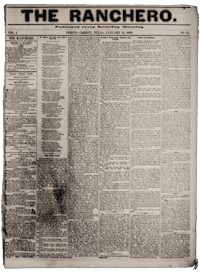The Ranchero [Corpus Christi, TX], October 6, 1860
Prof. Alexander, who has been to Huntsville lately, gives us the following items relative to the Penitentiary, which he visited while there. After being admitted through a massive iron gate, guarded by two sentinels; he was placed in the charge of a warden who conducted him over the building. All the cells are clean, some ornamented with pictures, etc. There are 201 prisoners in all, 150 of whom are in the weaving room. They weave cotton and woolen goods of divers qualities. There are 70 Mexicans, in for horse stealing; one woman, an accomplice in a murder case. In another room they make furniture, shoes, and do the tailoring for the tailoring for the establishment; in another place blacksmith is done. The Mexicans do the cooking and washing for the prisoners. The mode of punishment is the stocks; the neck and wrists of the refractory criminal is placed within a circle of wood, too small to allow the head or hands to pass through; this frame is elevated so that the culprit barely touches with his toes and there fastened he stands until he promises better behavior. Another punishment is the dark cell or black hole—it is painted black and the culprit remains in solitary confinement in the darkness and stillness that is oppressive in the extreme—starvation is also resorted to. One cell the Professor noticed, had this inscription over it: “William Brown, aged 24 years, convicted of murder in Grimes county, in 1858, for which he is now suffering solitary confinement for life.” He weeps constantly, it is said.—Crockett Printer.
